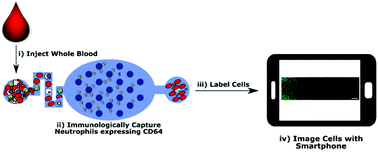Smartphone-imaged microfluidic biochip for measuring CD64 expression from whole blood†
Abstract
Sepsis, a life-threatening syndrome that contributes to millions of deaths annually worldwide, represents a moral and economic burden to the healthcare system. Although no single, or even a combination of biomarkers has been validated for the diagnosis of sepsis, multiple studies have shown the high specificity of CD64 expression on neutrophils (nCD64) to sepsis. The analysis of elevated nCD64 in the first 2–6 hours after infection during the pro-inflammatory stage could significantly contribute to early sepsis diagnosis. Therefore, a rapid and automated device to periodically measure nCD64 expression at the point-of-care (POC) could lead to timely medical intervention and reduced mortality rates. Current accepted technologies for measuring nCD64 expression, such as flow cytometry, require manual sample preparation and long incubation times. For POC applications, however, the technology should be able to measure nCD64 expression with little to no sample preparation. In this paper, we demonstrate a smartphone-imaged microfluidic biochip for detecting nCD64 expression in under 50 min. In our assay, first unprocessed whole blood is injected into a capture chamber to immunologically capture nCD64 along a staggered array of pillars, which were previously functionalized with an antibody against CD64. Then, an image of the capture channel is taken using a smartphone-based microscope. This image is used to measure the cumulative fraction of captured cells (γ) as a function of length in the channel. During the image analysis, a statistical model is fitted to γ in order to extract the probability of capture of neutrophils per collision with a pillar (ε). The fitting shows a strong correlation with nCD64 expression measured using flow cytometry (R2 = 0.82). Finally, the applicability of the device to sepsis was demonstrated by analyzing nCD64 from 8 patients (37 blood samples analyzed) along the time they were admitted to the hospital. Results from this analysis, obtained using the smartphone-imaged microfluidic biochip were compared with flow cytometry. Again, a correlation coefficient R2 = 0.82 (slope = 0.99) was obtained demonstrating a good linear correlation between the two techniques. Deployment of this technology in ICU could significantly enhance patient care worldwide.



 Please wait while we load your content...
Please wait while we load your content...